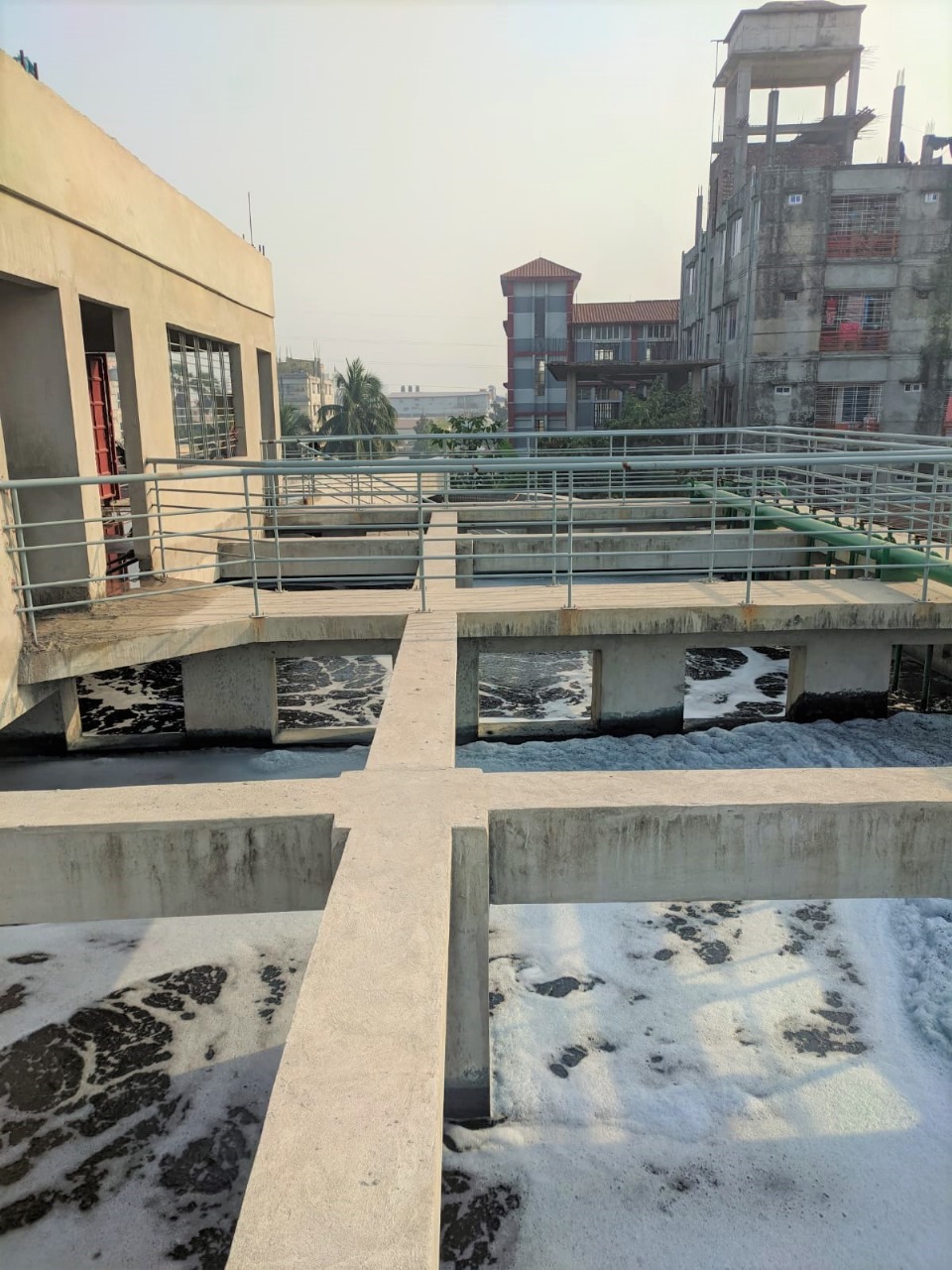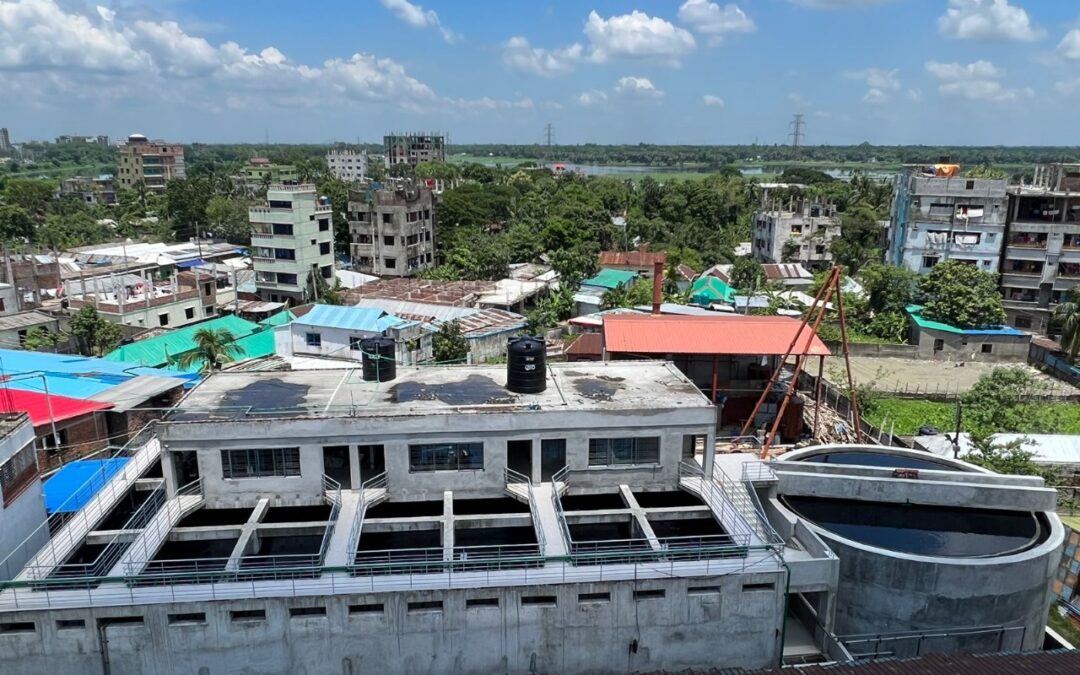Biological ETP for a Denim Washing Industry: A Case Study on SAP Fashions Ltd
Earth Squad has implemented a project for the construction of an Effluent Treatment Plant (ETP) at SAP Fashions Ltd. to ensure the proper treatment of wastewater generated during the production processes. The goal is to meet environmental compliance standards set by the Department of Environment (DoE) of Bangladesh as well as international buyer’s compliance standard.
SAP Fashions Ltd. operates in the textile and apparel sector, involving the Denim washing process, and finishing. These activities generate significant quantities of wastewater, characterized by high levels of Chemical Oxygen Demand (COD), Biochemical Oxygen Demand (BOD), Total Suspended Solids (TSS), and pH variations. Effective wastewater treatment is essential to reduce environmental impact and achieve sustainability goals.
Earth Squad’s scope of work for this project included:
- Detailed design and engineering of the effluent treatment facilities
- Preparation of civil and equipment drawings
- Manufacturing and supply of all required mechanical equipment
- Installation and commissioning of the plant
- Providing a comprehensive operation and maintenance manual
Key Features of the ETP

Key Challenges
- Compliance with DoE Standards: Ensuring treated effluent meets permissible limits for COD, BOD, TSS, and pH.
- Incoming Sand from Denim Washing: The use of pumice stones in denim washing generates sand-like particles, which can pose challenges to the effective functioning of the Effluent Treatment Plant (ETP).
- High Organic Load: The denim washing process generates wastewater with high organic content, requiring robust treatment.
- Chemical Variations: The use of Enzymes, non-ionic surfactants, sodium hypochlorite, hydrogen peroxide, acetic acid, cationic softeners, and silicone emulsions and auxiliary chemicals results in fluctuating wastewater characteristics.
- Sludge Management: Efficient handling and disposal of sludge produced during the treatment process.
- Energy Efficiency: Balancing treatment efficacy with operational energy consumption.
Earth Squad designed and implemented the advanced ETP featuring:
Sand Separation Tank
This tank is designed to remove large particles and sand from wastewater. This is typically done using a sand separator, which allows the heavier sand to settle at the bottom while the water flows over. Pumice stone is used in denim washing so this part is crucial for running the ETP efficiently. (Solution of no. 2 problem)
The wastewater flow and composition can vary greatly throughout the day. The equalization tank helps to smooth out these variations by storing and gradually releasing the wastewater. This creates a more consistent flow for the downstream treatment processes.
Aeration Tank
This is a crucial step in biological treatment. Air has been pumped into the tank with the help of blowers. Wastewater is mixed with air in the aeration tank to introduce oxygen. This oxygen supports the growth of microorganisms that break down organic matter (like food scraps and sewage) into simpler, less harmful substances. Wastewater is mixed with air in the aeration tank to introduce oxygen. (Solution of no. 2 problem)

Figure: Aeration Tank
MGF stands for “Multi-Grade Filter. “This filter vessel uses a combination of different filter media (like sand, gravel, and anthracite) to remove suspended solids, colloidal particles, and other impurities from the wastewater. (Solution of no. 2 problem)
The clarifier tank allows the settled solids (sludge) to separate from the treated water. The lighter, treated water flows out the top, while the sludge settles at the bottom.

Figure: MGF Filter Vessel

The sludge collected from the clarifier is often quite watery. The sludge thickening tank concentrates the sludge by removing excess water. This reduces the volume of sludge that needs to be further treated or disposed of.
This tank temporarily stores the thickened sludge before it undergoes further treatment or disposal.
The Filter Press is a mechanical device used to dewater the sludge. It applies pressure to the sludge, squeezing out excess water and producing a drier, more solid material (sludge cake).
The sludge cake is the solid residue left after the dewatering process. It can be further dried, often using solar drying, to reduce its moisture content even more. This makes it easier to handle transport and disposal of.
Characteristics of the ETP
Intlet Parameters
- COD: 800 mg/L
- BOD: 350- mg/L
- TSS: 350 mg/L
- pH: 7.5-12.0
Outlet Parameters
- COD: < 200 mg/L
- BOD: < 30 mg/L
- TSS: 100 mg/L
- pH: 6.0-9.0
Achieves significant reductions in pollutant levels to meet or exceed DoE discharge standards.
Reduced Environmental Impact & Regulatory Compliance: Minimizes pollution and protects nearby water bodies. Ensures compliance with DoE standards for effluent discharge.
Cost Savings, Sustainable Operations & Resource Recovery: Optimized operations reduce energy and chemical consumption. Supports SAP Fashions Ltd. in achieving sustainability targets. Potential reuse of treated water in non-potable applications.
The successful implementation of ETP at SAP Fashions Ltd. demonstrates Earth Squad’s expertise in delivering efficient and sustainable wastewater treatment solutions. The project has resulted in:
- COD reduction by 75% (from 800 mg/L to 200 mg/L).
- BOD reduction by 91.4% (from 350 mg/L to 30 mg/L).
- TSS reduction by 71.4% (from 1,200 mg/L to 30 mg/L).
- Stable pH adjustment from 10 to 7.5.
The SAP Fashions Ltd. ETP project stands as a benchmark for textile industry wastewater management. The innovative design and implementation by Earth Squad ensures environmental safety and operational sustainability, setting a precedent for other industrial sectors to follow.

